UNDERGRADUATE RESEARCH BLOGS
The Office of Undergraduate Research sponsors a number of grant programs, including the Circumnavigator Club Foundation’s Around-the-World Study Grant and the Undergraduate Research Grant. Some of the students on these grants end up traveling and having a variety of amazing experiences. We wanted to give some of them the opportunity to share these experiences with the broader public. It is our hope that this opportunity to blog will deepen the experiences for these students by giving them a forum for reflection; we also hope these blogs can help open the eyes of others to those reflections/experiences as well. Through these blogs, perhaps we all can enjoy the ride as much as they will.
EXPLORE THE BLOGS
- Linguistic Sketchbook
- Birth Control Bans to Contraceptive Care
- A Global Song: Chris LaMountain’s Circumnavigator’s Blog
- Alex Robins’ 2006 Circumnavigator’s Blog
- American Sexual Assault in a Global Context
- Beyond Pro-GMO and Anti-GMO
- Chris Ahern’s 2007 Circumnavigator’s Blog
- Digital Citizen
- From Local Farms to Urban Tables
- Harris Sockel’s Circumnavigator’s Blog 2008
- Kimani Isaac: Adventures Abroad and At Home
- Sarah Rose Graber’s 2004 Circumnavigator’s Blog
- The El Sistema Expedition
- The World is a Book: A Page in Rwand
Ana
Ana de Souza

Please provide a brief summary of your research.
Anterior temporal lobectomy (ATL) involves the surgical resection of left or right medial temporal lobe (MTL) structures to control seizures in 80% of patients with medication-resistant temporal lobe epilepsy (TLE). MTL supports the formation and retrieval of memories for past experiences, so the benefits associated with ATL must be balanced with the risks of memory decline. Currently, presurgical memory lateralization relies on an invasive procedure called the Wada test, which can be inaccurate, particularly in younger children or those with developmental delays. This project aims to improve memory outcomes in pediatric TLE patients by using fMRI to determine memory lateralization prior to left or right ATL. To achieve this, we designed two memory tasks to be performed in-scanner, one examining associative memory and one examining naturalistic event memory. In healthy participants, we hypothesize bilateral MTL activation during the performance of both tasks. In patients with left or right TLE, we hypothesize greater activation lateralized to the non-epileptic MTL. Now, we are leading pilot testing of the memory tasks and subsequent data collection in healthy children and adolescents. Once we analyze the data, we plan to recommend one or both tasks to be paired with fMRI and employed in the presurgical evaluation of pediatric TLE patients. We further plan to pair the tasks with intracranial EEG during presurgical monitoring to examine the neurophysiological mechanisms underlying fMRI effects. We hope the findings of this project indicate that our clinical memory task method can replace the Wada test for patients being considered for ATL.
What made you initially interested in researching your project in particular?
My major (Industrial Engineering) is not related to this area, but I took an Intro to Psychology class and became genuinely interested in Neuroscience topics. I wanted to learn more about it and I also thought it would be fun to work with kids when we got to the data collection phase! My major is very quantitative (a lot of Statistics and Computer Science), so I was very excited about applying my theoretical knowledge to this project, especially because I was so interested in it.
What made you interested in pursuing (interdisciplinary) research more broadly?
First, I wanted to find a hands-on experience to apply all the theoretical things I am learning at Northwestern. Second, I was curious about what doing research would be like; I had never been part of a research project before and wanted to try it out.
Describe your experiences with research thus far. Was it tricky? What skills do you think you’ve gained?
I had a great experience! Dr. Johnson (my faculty mentor) was very supportive and willing to teach me. While I was coding the behavioral tasks, I also had a lot of autonomy, which was very exciting. Though this project, I ended up discovering I really enjoy Neuroscience! The projects I am working on are challenging but the support of my lab and my genuine interest in the research keep me going. Two of the most important skills I’ve gained are not being afraid to ask for help and not running away from challenges.
Any tips or advice you have for students similar to you that are interested in pursuing undergraduate research?
Find something that you are genuinely interested in – this will make a huge difference in the long run! Also, don’t give up on finding a lab and use the Office of Undergraduate Research resources.
If you had unlimited time, money, resources, support, etc. what is something you would research?
I would still research the same thing!
What is your most useless talent?
If I feel tired, I can sleep anywhere. And I really mean anywhere.
Betty
Betty Dong
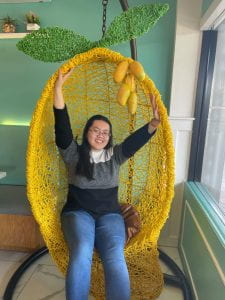
Please provide a brief summary of your research.
I helped Melissa gather sources from academic papers to video interviews for a book about history of Hip-Hop— from its origins to various stylistic methods that artists implement today. In addition, I also worked on restyling some presentations for her vocal classes.
What made you initially interested in researching your project in particular?
I like music and history! I wanted to get exposed to more types of music and be more knowledgeable in regards to different cultures and genres. Melissa was also a lovely faculty-in-residence for the South Area last year <3
What made you interested in pursuing (interdisciplinary) research more broadly?
I like many things but I wasn’t sure if I should do research, so I just decided to try it out. Interdisciplinary fields seem to flow naturally with any subject, since the world is connected to each other.
Describe your experiences with research thus far. Was it tricky? What skills do you think you’ve gained?
Overall, it was really fun! I had the opportunity to both enjoy summer and learn more about how to actually do research. I think time management and clear communication were skills that I’ve gained throughout this experience.
Any tips or advice you have for students similar to you that are interested in pursuing undergraduate research?
Try it out! If you like it, that’s great. If you don’t, at least you know you won’t be a researcher for the rest of your life. No regret-life.
Favorite bathroom on campus?
One of the fancy ones in Kellogg or the Allen Center
What’s the most interesting thing you’ve learned/read about/listened to this week?
Sign — ONEW
Ani
Ani Feinberg
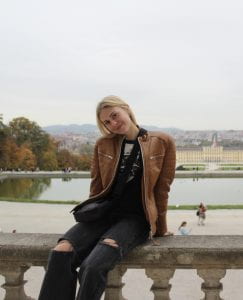
Please provide a brief summary of your research.
Last summer, I had the privilege of working with Professor Larissa Buchholz to create a systematic literature review for her research project on the globalization of art and cultural production. Literature reviews are an essential first step in any research project because they help the research team gauge how much information is available on their topics of interest, as well as the types of questions that have already been asked. Using the online platform Endnote, I developed of bibliographical archive of all the pre-existing research and writing that was relevant to art and globalization. Towards the end of the summer, I worked on analyzing all this literature, identifying common themes and significant patterns that guided Professor Buchholz in her own research the following fall.
What made you initially interested in researching your project in particular?
I was initially drawn to this research project because of my interests in International Affairs and my background in the arts world. I was a ballet dancer all throughout high school (and briefly into college!), and I felt that Professor Buchholz’s work was the perfect blend of this particular passion and my separate academic pursuits. In the classroom, I have studied quite a bit how globalization has impacted the world economy, politics, and social activism–however, before joining this project, I had yet to truly explore the intersection of globalization and art forms (such as dance, poetry, painting, films, music, etc.). It is truly fascinating to question what motivates humans around the world to share, invent, and mimic these different practices. Professor Buchholz’s project allowed me to explore a field of study I was both extremely unfamiliar with and highly curious about.
What made you interested in pursuing (interdisciplinary) research more broadly?
I am a firm believer that the research process teaches valuable practices that can be applied to almost any career path. I knew that by pursuing some form of research, I would help to improve my organizational, collaborative, and analytical skills enormously.
Describe your experiences with research thus far. Was it tricky? What skills do you think you’ve gained?
My experience was definitely not easy. Prior to this research, I did not have much experience with coding or computer software tools, and it took a good amount of practice to get to a place where I was comfortable inputting all of our work into various online databases. Nonetheless, this just reminded me of my ability to learn quickly and adapt to changes, even well into my college career. I walked away from this experience feeling much more confident using technology as a means for more efficient research collection and analysis.
Any tips or advice you have for students similar to you that are interested in pursuing undergraduate research?
Even if you do not think it will be an important aspect of your career later on, give undergraduate research a try! There’s no better time to try new kinds of work and learning than in college. You have nothing to lose with research–only skills to be gained.
Elizabeth
Elizabeth Hyun
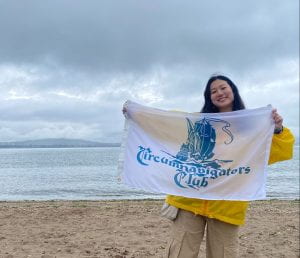
Can you briefly summarize your project and share what made you initially interested in that topic?
My project focused on psychological trauma across 5 different countries: Argentina, Northern Ireland, Bosnia, Japan, and South Korea. I became interested in this topic while taking a class on trauma in the Global Health Department in the fall of my Junior year. In the class, I realized that I had a lot of questions about trauma and mental health. For example, I was curious about how perceptions of trauma and spaces for trauma care differed across distinct cultural contexts. My research this summer helped me to answer some of these questions and allowed me to learn from incredible experts in the field.
What was the most unexpected or challenging part of your trip?
The most challenging part of my trip was conducting interviews with multiple language barriers. Even though most of my interviewees were fluent in English, it was still difficult to translate some words regarding trauma and psychology. Also, there are always words that don’t completely translate into another language. So, when my interviewees would talk about their life experiences, sometimes it was challenging to authentically understand their experiences and emotions.
In what ways do you think circumnavigating the globe helped you grow?
I think this is a tough question and one that I am still in the process of realizing. I believe that this trip helped me to grow in many different ways. I learned how to enjoy my own company, how to become comfortable with being uncomfortable, and how to connect with people from different backgrounds and across different ages. I learned the importance of flexibility and open-mindedness in traveling. Finally, I learned that there are many different versions of living a successful, happy, and meaningful life, that there isn’t just one designated way for doing things.
What did you miss most from home while you were abroad?
My friends and family. And AC.
Do you have any advice for students interested in the Circumnavigator Grant?
My advice for anyone interested in this grant would be to apply. I think that this is a once in a lifetime opportunity and the rewards from this experience outweigh the challenges during the application process. Also, there are so many people at Northwestern who are here to support you!
Morgan
Morgan Willison
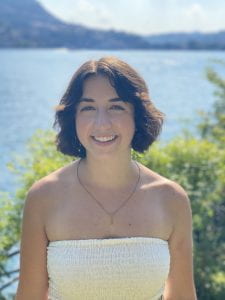
Please provide the tile and a brief summary of your research/conference presentation.
Title: How Do Transgender and Non-Binary College Students Define ‘Having Sex’? My research investigated how transgender and non-binary college students define the phrase ‘having sex’ and the factors that influence those definitions. I interviewed 8 self-identified non-cisgender college students and used a phenomenology framework of analysis to code for significant themes. The findings of my research reveal how participants’ gender identities impact their sexual experiences and highlights their need to redefine and construct their own definitions of ‘having sex,’ outside of the cis-heteronormative definitions that they learned from Sex Education classes, popular media, or their peers.
What made you initially interested in researching your project in particular?
In my first sexuality studies class at Northwestern (shout out Introduction to Sexuality Studies with Professor Fenrich), we had a guest lecture by Linguistics Professor Gregory Ward on how several populations define ‘having sex.’ Looking at the existing scholarship, I realized how each study, even the queer-friendly ones, relied on a strict gender binary and the conformity of its participants’ bodies to cisgender norms. I was interested in adding transgender and non-binary voices to this incredibly important conversation that affects sex education curriculum, medical inquiry into sexual behavior, and support for sexual well-being.
What conference(s) did you present at and how did you find out about them?
Moving Transgender History Forward 2023 at the University of Victoria; I was looking for places to submit my work as I had just begun writing up the final article and got really lucky to stumble upon their information!
What was it like presenting at a conference? Anything that you didn’t expect?
I presented a virtual poster so I actually got to record a video presentation to submit before the conference began. I really appreciated that as it eased some of the nerves of presenting my research for the first time. As the conference wasn’t only for undergraduates, I went in expecting no one to be interested in my work, as they were mostly graduate students and professors but everyone was really kind! Throughout the conference, so many people asked about my work and future interests and even offered to put me in contact with others working on similar projects!
Any tips or advice you have for students similar to you that are interested in presenting at a conference one day?
I would absolutely recommend it. If you’re anxious about presenting in front of a crowd, look for virtual options so you know your presentation is already complete and you can focus on learning from and talking with others! Also, it can be intimidating to ask questions of presenters but I haven’t had a bad experience yet, and usually they’re just thrilled someone is interested in learning more. A great question to ask if you’re not sure what to say but want to start a conversation with them is “was there anything really interesting about your research that you didn’t get to share in the presentation?”
What is your most useless talent?
I can make my tongue roll into a clover shape!
Yao
Yao Xiao
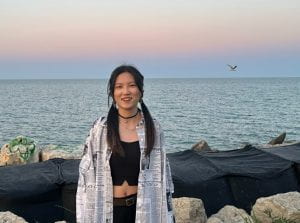
Please provide a brief summary of your research.
My research project looked into the role of insights, or “Aha” moments, in mathematical problem-solving. It turned out that people did experience insights, sometimes multiple, when solving a math problem. What’s more, people are more likely to reach a correct answer, and more confident in the correctness of their solutions if they experienced insights when solving math problems. These suggest that insight may play an important role in facilitating math problem-solving and providing a more positive subjective experience of doing math. My results are interesting in that they provided a new perspective to look at math problem-solving. People often think math is step-by-step and boring, while being intimidating. But my research suggests that creativity and spontaneity are important parts of math as well, and maybe they should be emphasized more in math education in real life. Besides, my results hint that insights might have various functions besides leading to the solutions directly, contributing to our current understanding of insights.
What made you initially interested in researching your project in particular?
I major in both psychology and math. When I learned about the concept of insights, or “Aha” moments, I immediately related it to my own experience of doing math. Then, I had the luck to meet my supervisor who also has background in math and resonates with me on the math insight experience. What’s more, math insights are frequently suggested in the anecdotes of famous mathematicians. However, the research on this phenomenon is very limited. So with the curiosity on this special cognitive process in math problem-solving, I became interested in conducting my AYURG project.
What made you interested in pursuing (interdisciplinary) research more broadly?
Curiosity! I am always inclined to probe into the “why”s and “how”s in life, even if they seem trivial. When I work out a math problem, succeed in doing a tricky movement on ice skates, etc., I often jump out of the moment and think: how did that happen? Research is a great way to find out the answers of millions of such questions in my mind. I am also excited to see how research can make a difference in the world via understanding the world better.
Describe your experiences with research thus far. Was it tricky? What skills do you think you’ve gained?
I think the trickiest part of research for me is to communicate it with others, while it is one of the most important parts of research. I have learned repetitively that I can’t assume others know my research project as well as I do when I explain it to them. Realizing this, I am hopefully growing to be a better speaker and listener.
Any tips or advice you have for students similar to you that are interested in pursuing undergraduate research?
Go for it! No research question is too trivial to probe into. Also, be sure to share your research with others. Sharing will probably be more rewarding and inspiring than you would imagine.
What is your most useless talent?
Sensing that a *gorgeous* sunset is going to happen
Marina
Marina Jardim
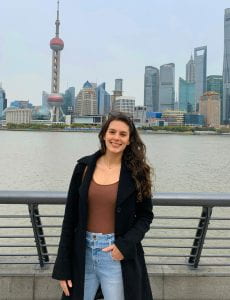
Please provide a brief summary of your research.
My research investigated how two proteins, dynein and ZYG-8, work together to promote proper spindle assembly during meiosis in C. elegans eggs. Meiosis is a type of cell division that creates eggs (oocytes) and sperm. Proper spindle assembly is vital for proper chromosome segregation during meiosis, which is needed to produce viable sex cells. Although structures known as centrosomes organize spindles during mitosis, they are absent in oocyte meiosis. Recent research at the Wignall Lab shows that these acentrosomal spindles are formed and stabilized by a variety of proteins in C. elegans oocytes, which are found in similar forms (homologs) in humans. Two of these proteins are dynein and ZYG-8, but their interactions with each other–if there are any–were still unknown. Therefore, my goal was to investigate how these two proteins might interact to assemble and maintain proper acentrosomal spindles, and promote proper chromosome segregation during oocyte meiosis.
What made you initially interested in researching your project in particular?
When I first came across the research at the Wignall Lab, I was marveled by their findings and ongoing projects. As a Pre-Med interested in molecular biology and OB-Gyn, investigating factors that contribute to the formation of viable oocytes immediately piqued my interest. Dr. Sadie Wignall and her graduate students’ research are providing a broader and more detailed understanding of proper spindle formation, which is a step towards understanding the underlying causes of birth defects and miscarriages in humans. One of the graduate students at the lab, Emily Czajkowski, needed help with her research. After spending a full quarter training and helping Emily advance her experiments, I decided to continue at the Wignall lab and launch my project to potentially expand her research!
What made you interested in pursuing (interdisciplinary) research more broadly?
I applied for the URAP program because I wanted to see if research was right for me. Even though I spent hours in the lab for my Pre-Med classes, I knew that research outside of the classroom would be different. I spent one quarter training with my mentor, Emily, who is part of the Interdisciplinary Biological Sciences Graduate Program. I thoroughly enjoyed problem solving and having deep discussions on our experimental results, which required an interdisciplinary approach. At the end of the quarter, I knew research was something I wanted to pursue further through URAP to continue applying my knowledge, practicing my critical thinking skills, and contributing to exciting, pioneering research.
Describe your experiences with research thus far. Was it tricky? What skills do you think you’ve gained?
Through this experience, I learned the ins and outs of scientific research; it can be procedurally complex, and a lot of times, things that may work in theory might not work in practice. Research is a constant process of trial and error, but when you get those “wins” and reach new conclusions, the process becomes rewarding and exciting. I learned a variety of wet-lab skills, how to use one of the world’s most sophisticated microscopes (Deltavision), and the importance of peer discussion and collaboration. Science is often seen as a competitive field, but this experience has shown me that it is rather a supportive space, driven by collaboration.
Any tips or advice you have for students similar to you that are interested in pursuing undergraduate research?
If you are interested in pursuing undergraduate research, I would highly recommend the URAP program! You will learn a lot from the incredible graduate students and faculty at our university, form meaningful professional relationships, and gain a greater insight into their ground-breaking work. I would suggest that you learn about the ongoing research happening on campus and reach out to a professor whose research appeals to you. Sometimes it takes multiple emails to reach them, but take advantage of the URAP advisors to craft a nice letter and don’t give up until you get a response! Finally, I would suggest getting to know the professor or graduate student you are interested in working with before asking for or committing to a research opportunity. This way you can ensure your goals align with theirs, and that you will become great partners in the future.

Heading Back Home
Hi everyone.
I’m writing this one from the airplane. After almost 3 months of traveling, I am finally heading back to the United States.
I went to 5 countries this summer – all by myself!
Even though it’s ending now, this is still hard for me to believe. I had always wanted to travel, explore different cultures, and chase my passions in college, but I never dreamed of having an opportunity as amazing as this. I actually circumnavigated the globe! I have met so many wonderful people, both through my research and separate from it. I have shared so many meaningful conversations with them and learned so much – about trauma and mental health and also about life.
This summer, I saw 3 different types of seas – one from the harbor, one in the pouring rain, and one under the hot sun. I walked on a mountain named after giants. I went to museums, explored government buildings, and ate at hole in the wall restaurants. I celebrated my birthday in Eastern Europe and got sent to the emergency room in East Asia. I have gotten to do so much, more than I can possibly write down, in all different part of the world!
And I am so, so grateful for it all.
I wish that I had clearer conclusions from my trip. I wish that I could concretely organize everything that I’ve seen and felt and experienced into this blog post, but right now, I honestly feel like a jumble of emotions.
For some reason, I feel as I did when I first headed to Northwestern. Just like I did back then, I feel excited for the future – to reunite with my family and friends and to dive deep into the research I did this summer. And I feel sad; it feels like I am saying goodbye to something, like some kind of chapter in my life is ending. I also feel nervous about adjusting to school again, to my ‘normal’ life. But at the same time, if I’ve learned anything this summer – I think it is that there is no ‘normal’ life. I did just as much unlearning as learning these past few months. I have witnessed so many different types of successful and different versions of happy and different ways of living meaningfully across my travels.
From now on, I want to try and make sure that I’m asking myself if I am making decisions because they are what I want to do or because they are what I believe that I should do. It’s paradoxical, but I feel as if I know myself more and less all at the same time.
Anyways, I apologize that this post is mostly just me rambling 😅 I think that over the next few weeks (as I write my paper and review my experiences), I will get a clearer picture of this trip in my head.
In conclusion, I want to say thank you to everyone reading. Thank you so much for supporting me and for being a part of this unbelievable journey. This will definitely be a summer I will always remember.
Thanks for reading 💌

안녕 Seoul: My Last Week
Monday (Day 16): Today, we went to visit my uncle in Yongsan, a district of Seoul that houses the Korean ‘pentagon’. My uncle is a military general, so we thought that we might get to see inside the building. However, we weren’t allowed to visit because the Korean president is currently working there during the day. It was interesting to hear about Korean politics. Usually, the president is supposed to live and work in the Blue House. But the current president decided not to live there after he consulted with his shaman who told him that he needed to live in a building with underground bunkers… 😅
Anyways, after having lunch at my uncle’s house, we decided to visit the National Museum of Korea. This museum is absolutely stunning. The outside area gives a view of Namsan tower, and the exhibits inside are arranged in a really clever and organized way. I had a genuinely fun time looking at all of the exhibitions. Not only did I learn more about Korean history, I also learned more about East Asian history as a whole: the museum showcases artifacts from all over the world – including China and Japan. There is also a Hangeul Museum (Hangeul is the official Korean language), but we didn’t have time to visit it today. Hopefully, next time I’ll be able to explore that museum as well!
Wednesday (Day 18): My aunt did not have work today, so the four of us decided to take a day trip to Gimpo, an area adjacent to Seoul. First, we went to the world’s biggest cafe! It was 5 stories tall and included photo rooms, a variety of seating options, and a cheese and wine bar; half of the first floor was even dedicated to fresh pastries. We bought so many different types of bread to try, and everything was so delicious!
Next, we went over to Laveniche March Avenue. We rented a boat, and I got to drive it down the river! Before we got on the boat, it was raining pretty heavily. But right before it was time to get on, the rain stopped, and we saw a double rainbow! I think this was the first time I have ever seen a full rainbow; the experience felt magical. As we rode the boat, colored lights came on and illuminated the river. We got to enjoy looking at all of the shops and restaurants on the riverwalk, and I felt like I was inside of a scene from a Korean drama 😁
Saturday (Day 21): I saw Oppenheimer today with my cousin. The acting and the cinematography was superb, and the story in itself was encaptivating (as well as a bit overwhelming to digest). However, what amazed me the most was the score. Sitting in the theater, I couldn’t help but notice how I would tense up or relax with the constant pace of the music, and how the rare moments of silence in the movie would make me unconsciously hold my breath. Having seen Barbie in Bosnia, I’m happy to say that I have successfully incorporated Barbenheimer into my summer travels!
Monday (Day 23): I am leaving Korea tomorrow afternoon. I have spent most of today saying goodbye to family members who I most likely will not see for another few years. I am feeling a mix of emotions right now because this is not just the end of a trip to Korea but to all of my unforgettable travels this summer.
Thanks for reading 🖤

Seoul: More Research Insights
Thursday (Day 12): Today was another solo day for me: I had 2 interviews scheduled with psychologists at Adaptable Human Solutions (AHS), a private counseling center in Seoul. I took the subway in the morning to get to the center and was surprised to find that it was on the 25th floor of a Lotte Castle, which is a type of luxury building that houses residential apartments and businesses. I couldn’t help but compare the location of this counseling center to the ones that I had seen in my other countries. When I entered AHS, there were floor to ceiling glass windows in the waiting area that offered stunning views of the city, and there was even a beverage menu for guests to select from. For some reason, it didn’t feel like I was coming to receive a healthcare service. Rather, it felt like I was waiting to take part of a treatment far more elite. I’m not sure if this makes sense, but physically being in this space felt like a very different experience than the other on-site locations that I’ve been able to conduct interviews in.
My first interview was with an associate clinical psychologist. Interestingly, she received her license to practice therapy from Illinois. AHS offers therapy in both English and Korean, so my interviewee and I were able to have a conversation in English (which is easier for me when discussing psychological topics, even though I am generally fluent in Korean). She informed me that there are no strict regulations in Korea for practicing therapy. In other words, you can obtain a license from any other country and that license will be valid here without the need for further training or education.
We also talked about how the high suicide rate in South Korea was a reason for why she decided to come work here. But when we discussed the intake process at AHS, she mentioned how high risk clients are not accepted at the center. Instead, these clients are referred to psychiatrists and encouraged to go to major hospitals. This was interesting because our interview gave me the impression that therapy and mental healthcare are genuinely two distinct entities in Korea. I hope to better understand this phenomenon as I continue to review my research data.
My second interview was with a clinical psychologist at AHS who is a foreigner. She obtained her license and her doctorate degree from Scotland, and she decided to practice therapy in Korea because she liked the atmosphere of Seoul and wanted to live here. It was interesting to hear about the mental health landscape in South Korea from the lens of a foreign professional. She discussed comparisons that she couldn’t help but notice between Scotland and Korea when it came to the abundance of therapy centers or mental health advertisements.
Following my interviews, I caught up on some work at a nearby cafe!
Friday (Day 13): I had another interview scheduled today at Adaptable Human Solutions. This time I met with a clinical psychologist who had worked in the mental health field in South Korea for decades; she previously worked as a mental health professor at Ewha Women’s University as well as Yonsei University. Compared to the interviews that I had yesterday, today’s interviewee was able to provide me with a more native Korean perspective of trauma and therapy in this country.
Like Professor Seo, she also discussed systemic issues regarding therapy in Korea. For example, not only is any international therapy license considered valid in Korea, there is no licensing requirement at all. This means that anybody can open up a counseling or therapy center as long as they register that center with the government – this process functions the same as when setting up a new business. The only people that are licensed are psychologists that work with children, but even this license is very limited in what it allows psychologists to do. Because most psychologists are thus unlicensed, when unfathomable tragedies (such as the Sewol Ferry incident or the Itaewon incident) occur in the country, the ones that are providing emergency mental health services to the Korean population are not psychologists or therapists; they are mostly nurses and other healthcare professionals. These people usually do not have the training to appropriately care for traumatized individuals, so often, they will say the wrong thing that ends up negatively impacting the mental health of someone who is already suffering.
Fortunately, she informed me that a licensing process is currently being established in Korea by the national government. She hopes that this change will provide psychologists and therapists with a greater role in the healthcare system as well as help to remove some of the misunderstandings and stigma surrounding therapy.
Even though a lot of my interviews in Korea have highlighted issues rather than positive points in the country’s mental health scene, I am not disheartened by these conversations. Instead, I find it inspiring that professionals in the field are not afraid to acknowledge and criticize limitations and that the country, on a government level, is actively trying to change the system!
Thanks for reading 🖤








